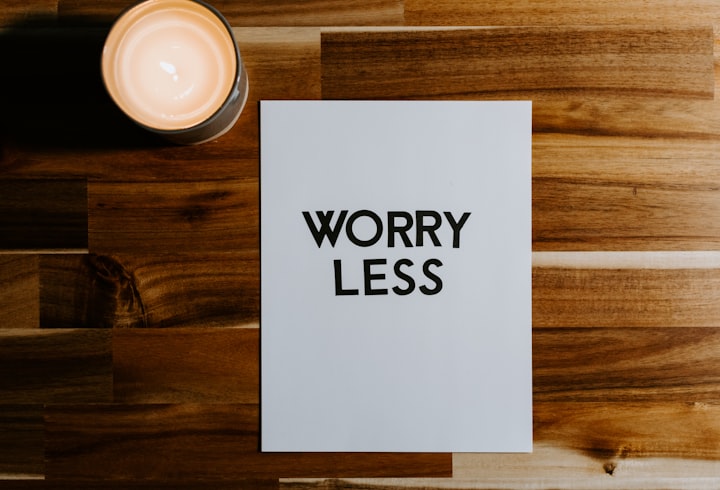How To Deal With Anxiety
Ease anxiety with this visualisation technique

Does anxiety bully you? Does it play a large part in your life? It doesn't have to be that way. There are many ways to control anxiety. This article will go over one visualisation technique in particular, but it's worth mentioning the basics also.
The front line to tackle anxiety are as follows:
- A clean diet, avoiding sugar and eating whole foods
- Avoiding drink and drugs
- Regular, good quality sleep
- Exercise
Do the basics first.
Tackling anxiety is a process. It is then worth addressing:
- Your work and career
- Your friendships
- Your family life
- Your relationship
There are no easy answers for these elements of life but anxiety can be the result of continued low-level stress, unhappiness and the feeling of being trapped.
Therapy is a good way to talk these problems through.
With these bases covered, and if anxiety is still giving you the occasional kicking, you can use advanced techniques to deal with anxiety as it rises in the moment.
This visualisation technique is one of them.
It’s not hard, but it does need you to put cynicism aside, as it sounds a bit weird.
I came up with this technique after working with a mindset coach and, by adding my own twist to what we talked through, I got something that worked for me.
Let's get into it.
The Puppy Technique to Deal with Rising Anxiety
It's called 'The Puppy Technique' because when I started, I visualized a puppy (that’s not the whole technique, by the way, just visualizing a cute dog, so stick with this), whereas now I visualize a little fluffy monster with tentacles.
Think this sounds crazy? Perhaps it is, but so is the human brain, so rise to meet that crazy son of a bitch head-on.
Here's the whole technique written below in steps. This visualisation is to be done at the point of anxiety arising.
Let’s begin.
Step One — Recognise the Anxiety
You begin to feel anxious. It might be because you’re about to do a presentation or a public performance. Perhaps it’s been triggered by work or social situation, an OCD symptom, or perhaps it’s just when you’re watching TV and your mind decides to do anxious backflips out of the blue.
Whatever the case, recognise the anxiety and accept it’s happening.
Do not fight it.
Try not to think, “Oh no.” Just recognise it with an almost scientific detachment and think, “Hmm, that’s interesting” like you’re observing something from afar.
Step Two — Visualise the Puppy
This is where the technique kicks in. But first, a quick explanation before we talk about the puppy.
What is happening when you get anxious is your brain is trying to warn you of danger when there isn’t any. It's not trying to hurt you; it’s not your enemy, your brain is your greatest, most loyal friend and ally. It loves you and wants you to be safe. You are a team. Team YOU.
Compare it to owning a puppy. Not a newborn puppy, but a mature one. Let’s say, ten months old. That mature puppy feels the same way about you as your brain does; it’s loyal, clingy, and loves you unconditionally. You are the puppy’s universe.
Now imagine a postman comes to the door. The puppy goes berserk. It thinks there’s danger. It wants to protect the house and it wants to protect you. It’s barking loudly, jumping around and ripping up the letters as they come through the door.
That’s your brain with anxiety. But whilst you'd tell the puppy it’s OK and to calm down (we might give it a hug or a rub), with our brain we do the exact opposite. We loathe it freaking out, we dread the anxious feeling, and we immediately push against it. This triggers a tailspin of negative emotion.
We need to change that.
Step Three — Put the Puppy On Your Shoulder
Now imagine the puppy is on your shoulder. Maybe shrink it down in your mind, whatever works. But imagine it’s there, barking like crazy in your ear, thinking there’s danger.
That is where the anxiety is coming from. Make it the source. That cute, loyal puppy on your shoulder. You’ve got all those feelings and you've put them into the puppy on your shoulder, who is currently going berserk, barking, and growling because it thinks there’s danger.
Step Four — Calm the Puppy
Now you need to internally talk to the puppy (or out loud if it helps!) and reassure it. Calm it down like a real puppy, barking at the postman.
Say to the cute puppy sitting “Shhh, it’s OK. There’s no danger. Thank you, but we’re all good.”
Thanking the puppy for warning you of danger is important. It changes your reaction from “Oh no!” to “Hey, thanks for trying to protect me.” Gratitude replaces fear.
A real-life puppy is only trying to help out of love. So is your brain. In puppy form or otherwise. If we put gratitude in the mix, it helps combat negative emotions.
Variations (How I Do It)
And that’s it. Reassure the puppy as much as needed. Talk to it. Or, if you want to skip the puppy bit altogether, reassure your brain. But I find it doesn’t work half as well as visualising something non-threatening.
I do the above steps but I have changed them over time. Instead of a puppy, I picture a fluffy monster with tentacles. It sits on my shoulder barking and making a fuss like a puppy would, but now and again, it stings me with a tentacle.
The tentacle shoots anxiety into me. That’s my fluffy monster giving me a helpful boost of energy and alertness to help me.
This is because when I am in a really anxious situation, I get waves of adrenaline. When I feel one, I think, “Thank you for the energy, fluffy monster, but we’re OK, it’s all OK.”
This helps me reframe the adrenaline I feel as helpful, almost a skill boost given to me by my protective monster. And I can be the one, reassuring the monster it’s OK. I’m the one in control, helping the monster understand that everything is fine. I feel in charge.
When you take the role of the "reassurer", and put the anxiety in puppy form, you suddenly have much more measure and control of the situation.
Give it a go. The mind responds to visualisation way more than vaguely attempting to control how to feel in a given situation.
Change it how you like. But please do try it. I find it helps immensely. In reality, you'll move through the steps in a second or two, I do. I’m telling the friendly monster on my shoulder to calm down while also feeling boosted and alert from the adrenaline (or tentacle).
Reframe anxiety as your friend. Your mind, the puppy, the fluffy monster is only helping Team YOU.
About the Creator
Jamie Jackson
Between two skies and towards the night.






Comments
There are no comments for this story
Be the first to respond and start the conversation.